Falls and preventing them
Key points about falls and falls prevention
- A fall at any age can be dangerous.
- Falls become increasingly common and are far more likely to cause injury after the age of 55.
- A fall can cause a number of problems, particularly if you live alone. Along with serious injury or fractures, you face a possible loss of independence and a knock to your confidence.
- Find out about the likely causes of falls, what you can do to help prevent them and how to prepare for what to do if you do have a fall.
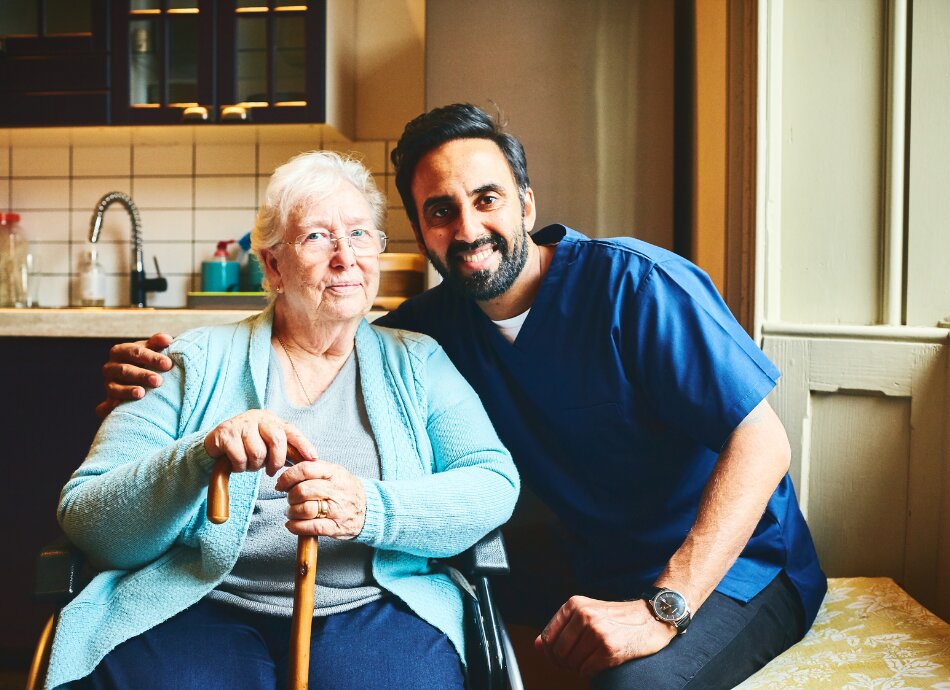
Some people, especially those who have had a fall, restrict what they do because of a fear of falling. While this sounds sensible, reduced activity actually puts you at a greater risk of falling. This is because it causes you to lose muscle strength and coordination.
So you don't get caught in this cycle, keep up the activities you enjoy and do them as safely as possible. The more you do, the more you can do.

Image credit: Healthify He Puna Waiora adapted from Subramaniam et al., 2022(external link)
Falls are more common as you get older due to:
- poor leg strength and impaired balance
- side effects from your medications
- other medical conditions
- eyesight problems
- nutritional deficiencies (if you're not eating enough or a balanced diet)
- hazards around the home environment.
You may not notice some these factors developing. Regular check-ups with your healthcare provider are a good way to spot them.
Each year about one-third of all New Zealanders over age 65 will fall at some time. Many of these falls result in broken bones.
You can play a role in preventing falls by doing taking the following steps:
Exercise regularly
Regular exercise is important in preventing falls. Benefits include:
- improved balance, muscle strength and flexibility
- stronger bones
- more energy
- better sleep
- better control of blood pressure, blood glucose and weight.
Lack of exercise can lead to weak legs, which increases the chances of falling. Any increased exercise is helpful.
General fitness can be improved by walking for 30 minutes most days of the week (or three 10-minute walks). You should work hard enough to breathe harder, but you should still be able to speak easily. Start with 5 minutes a day and build up if you need to.
Programmes designed specifically for balance and muscle strength have been shown to reduce the number of falls and injuries resulting from falls by between 30% and 50%. Modified tai chi classes are some of the most common ones. Tai chi is a gentle, controlled series of movements that help you develop strength, flexibility and balance. Find an exercise class near you(external link).
If you're at risk of falling, have a mobile phone nearby when you exercise. Please also stop exercising if you feel dizzy or are having chest pain, and rest if you need to.
Talk to your healthcare provider before starting or increasing any levels of exercise if you're unsure.
Read more about staying active over 65.
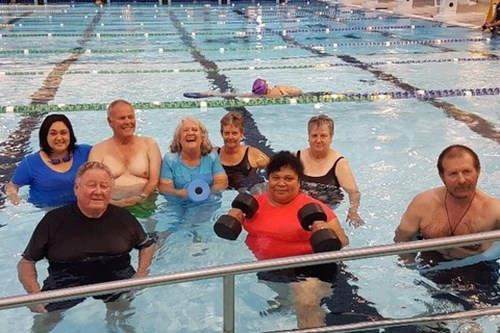
Image credit: Hora Te Pai Health Services
Apps and online resources
In Aotearoa New Zealand, the Live Stronger for Longer website(external link) by ACC, has practical information and advice on how to stay active, well and independent for people over 65 years of age and those caring for them. As well as a variety of resources on falls prevention, you can find community strength and balance classes and download the free Nymbl Training app.
- The Nymbl Training app has a range of body movements and exercises to help you improve and maintain your balance.
- The convenience of an app means that you can do the exercises whenever you want and wherever you are. It's easy to fit into your daily routine.
- The app is completely free and simple to use, and enrolling is easy.
- Learn more about the Nymbl Training app and other falls prevention apps.
Be mindful of your medicine
- Medications, or combinations of medications, may have side effects that can increase the risk of falls.
- Ask your healthcare provider or pharmacist to review all your medicines for side effects such as dizziness or drowsiness.
- Ask if there are medicines any that can be reduced or stopped.
- As you get older and need more medicines, taking them correctly gets harder, so work out a system to make sure you take the right tablets at the right time. Read more tips on how to remember to take medicines.
Read more about medicines and falls risk.
Keep your vision sharp
- Poor vision can make it harder to get around safely.
- Have your eyes checked every year.
- Wear glasses or contact lenses with the right prescription strength.
Read more about eyes and aging and eye tests.
Remove hazards at home
- About half of all falls happen at home.
- Make your home safer by reducing tripping hazards (eg, rugs) and clutter, adding handrails and improving lighting.
- Take care with pets in your home – it's easy to trip over them.
- Make sure you wear well-fitting slippers that include a back at the heel.
Follow the home safety checklist below to make sure your home is safe.
Video: Falls prevention exercises
Easy exercises you can do to improve your balance and prevent falls.
(NHS Morecambe Bay CCG, UK, 2021)
Otago exercise programme
Video 1: OTAGO-based falls prevention exercise program
In this and the following series of videos, Dr. Tiffany Shubert, Physical Therapist and expert in aging, health, and wellness leads you through a series of movements. These are proven to help improve your balance and strength so you can lead the lifestyle you want. Each video is about 35 minutes long.
(GiveFit, US, 2019)
Video 2: Otago: Falls Prevention Program (Workout #2)(external link)
Video 3: Otago: Falls Prevention Program (Workout #3)(external link)
Video 4: Otago: Falls Prevention Program (Workout #4)(external link)
Video: Falls prevention in children
About half of all falls happen at home. Make your home safer by reducing tripping hazards and clutter, adding hand-rails and improving lighting. Below are some potential trip hazards at home and how you can overcome them so you're less likely to fall at home.
Kitchen
Are the kitchen items you use every day within easy reach?
- Make sure they are within easy reach so you are not always stretching or bending too far.
- Use a hand reacher if needed.
- Use a safe step-ladder if you need to get things from high places.
- Make sure floor aren't slippery or wet.
Rugs
Are your rugs frayed at the edges, rolled at the corners, wrinkled or lumpy in the middle?
Do your rugs slip around when you walk over them?
- Make sure you repair, donate or replace them as they will make you trip.
- If your rugs slip around even just a little bit, make sure you anchor them with anti-slip mats.
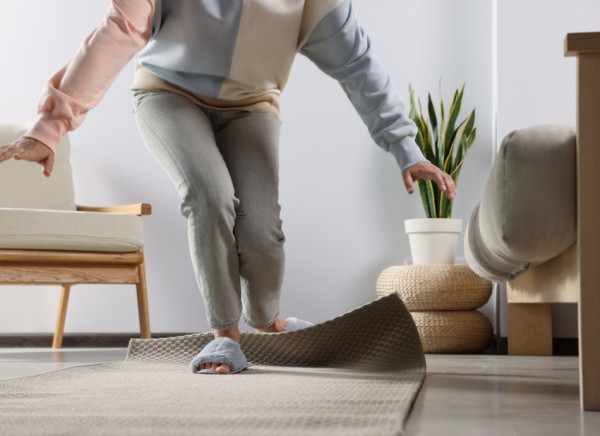
Image credit: Canva
Bathroom
Do you have a bathmat or a non-slip mat in the shower or bath?
Do you have handrails in your bath or shower for you to hold on?
What can you do if you feel unsteady or uncomfortable standing in the shower?
- Always use a bathmat or a non-slip mat in the shower if needed.
- Make sure you have handrails installed in your bathroom if you can't get in and out of the bath or shower easily.
- Use a bath-seat and handheld shower head if you feel unsteady standing in the shower.
Living room
Do you always bump into things if you walk through your house?
Can you reach your telephone comfortably from your chair?
Are electrical cords running across your walk-ways?
- Make sure you remove unnecessary items or furniture, or reduce the size of large items to create more clear space.
- Keep your phone close by at all times or get a cordless phone.
- Tie and tuck electrical cords under furniture or close to the wall.
Bedroom
Do you get unsteady or unbalanced in the morning?
Can you reach the bedside lamp or other things you need easily from the bed?
Are you're feet able to touch the floor when you're sitting on the side of the bed?
- Make sure you take your time getting out of bed and don't walk until you are ready. Try to roll onto your side, sit up slowly and then stand.
- Make sure the bedside lamp or other things you need are within easy reach of the bed.
- Adjust your bed height if you can't touch the floor when sitting on the side of the bed.
Outdoors
Do you need to bend over or stretch for long periods when gardening outdoors?
Do the paths outside your home ice up in winter?
- Make sure you use lightweight tools or long-handled equipment and avoid heavy lifting when gardening.
- Always use a handrail and apply salt and sand to an iced path.
Lighting
Are your lights bright enough but not so bright they create glare off surfaces?
- If your lights aren't bright enough, up the wattage of your light bulbs.
- Use nightlights if you need to get up often at night.
- Use lamps in areas where your ceiling lights don't reach.
People at risk of falls, or those who have had a fall in the past, may find it useful to have a medical alarm. These can make it easier to remain independent and continue living in your own home, especially if you live alone. They can also offer peace of mind for family members about your ongoing safety.
Medical alarms are usually worn as a pendant or wristband. You can activate the alarm if you have a fall and need medical help but can't get to the phone.
Having a medical alarm, keeping the phone near ground level and giving friends a spare key are useful precautions you can take in case one day you can't get up from a fall.
If you have a fall at home stay calm and decide whether to try to get up
If you can get up:
- bend your knees up, roll onto your side, then push up onto all fours
- crawl towards a sturdy chair
- use this support to help get yourself seated
- rest at any time if you need to, and then try again.
If you can't get up:
- use your medical alarm if you have one
- roll or crawl to the phone on the floor if you don't have an alarm
- if you're outside and don't have an alarm, call out to a neighbour if you can.
If you've had a fall, contact your family doctor (GP) as soon as possible. You must get an assessment of strength and balance to prevent further falls.
You can be referred to in-home or community classes to improve strength and balance. Please ask your healthcare provider for details of these. You can also refer yourself.(external link)
Falls prevention(external link) Age Concern, NZ
Physical activity and exercise(external link) Age Concern, NZ
Live stronger for longer(external link) ACC, Health Quality and Safety Commission & Ministry of Health, NZ
Apps
Falls prevention apps
Exercise apps for older adults
Brochures
Love your independence(external link) Ministry of Health, ACC and HQSC, NZ, 2018
Love your strength(external link) ACC, NZ, 2019
Love your hips(external link) ACC, NZ, 2019 Samoan(external link), Tongan(external link), Chinese(external link)
Home Safety Checklist [PDF, 5.5 MB] Ministry of Health, ACC and HQSC, NZ, 2017
Physical activity for older people (65+)(external link) Ministry of Health, NZ, 2013
Community strength and balance programme workout plans Level 1–2,(external link) Level 3(external link) Age Concern Auckland & Live Stronger, NZ
Mature and moving Sport Taranaki, NZ
- Sit and be fit (Level 1)(external link)
- Chair yoga (Level 1–2)(external link)
- Short Tai Chi routine (Level 2)(external link)
- Easy seated exercises (Level 1)(external link)
- Tai Chi for arthritis (Level 2)(external link)
- A 15 minute standing workout, only equipment needed is a chair and two tins or small bottles of water (Level 3)(external link)
Watch some falls prevention exercise videos above.
References
- Staying safe in your home(external link) Live Stronger, NZ, 2024
- Falls prevention(external link) Age Concern, NZ
- Physical activity(external link) Health New Zealand | Te Whatu Ora, NZ, updated 2024
See our page falls prevention for healthcare providers
Brochures
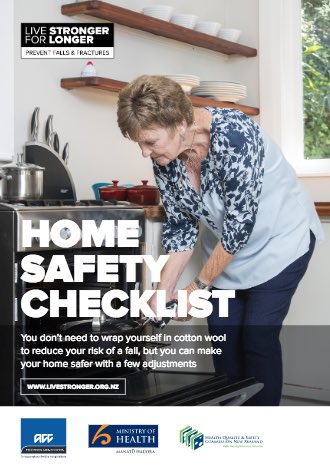
Ministry of Health, ACC and HQSC, NZ, 2017
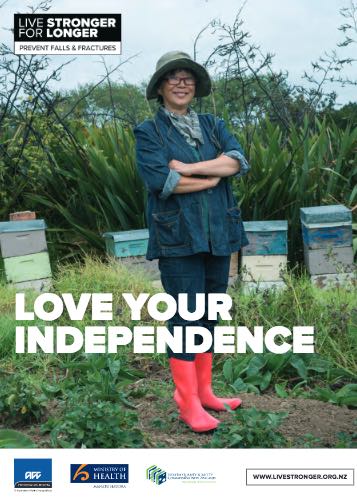
Ministry of Health, ACC and HQSC, NZ, 2018
Credits: Healthify editorial team. Healthify is brought to you by Health Navigator Charitable Trust.
Reviewed by: Kathy Gross, Physiotherapist, East Health Trust PHO, Auckland
Last reviewed:





